

All ketchups are hardly created equal, as you’ll see in our review of 42 different brands. Photo © Claudio Beldini |Fotolia.
|
STEPHANIE ZONIS is a Contributing Editor at THE NIBBLE.
|
|
October 2007
Updated November 2008
|
 |
A Fresh Look At Ketchup
Page 4: Ketchup Today ~ What Is “Tomato Concentrate?”
This is Page 4 of a nine-page article. Click on the black links below to visit other pages.
Ketchup Today
The sheer volume of ketchup sold worldwide in the 21st century is staggering. While  the Big Three of the industrial ketchup world are Heinz, Hunt’s and Del Monte, it is indisputable that Heinz retains the lion’s share of the market. Heinz Tomato Ketchup is sold in 150 countries, according to their U.K. foodservice website. The company sells 11 billion bottles of this condiment every year, and Heinz has dominant market share in almost every nation where it competes with one or more other brands. Given multiple types of popular diets and eating styles and the surging popularity of salsa, however, even this tomato titan has had to do some innovating. In addition to their old standby, Heinz now produces Organic; No Salt; Reduced Sugar; and Hot and Spicy Ketchup Kickrs varieties. Heinz even allows consumers to purchase bottles of ketchup with custom-worded labels, through the MyHeinz.com website. the Big Three of the industrial ketchup world are Heinz, Hunt’s and Del Monte, it is indisputable that Heinz retains the lion’s share of the market. Heinz Tomato Ketchup is sold in 150 countries, according to their U.K. foodservice website. The company sells 11 billion bottles of this condiment every year, and Heinz has dominant market share in almost every nation where it competes with one or more other brands. Given multiple types of popular diets and eating styles and the surging popularity of salsa, however, even this tomato titan has had to do some innovating. In addition to their old standby, Heinz now produces Organic; No Salt; Reduced Sugar; and Hot and Spicy Ketchup Kickrs varieties. Heinz even allows consumers to purchase bottles of ketchup with custom-worded labels, through the MyHeinz.com website.
If you look at the ingredient list of any tomato ketchups produced by the Big Three, you’ll notice that the first ingredient is “tomato concentrate.” But what is tomato concentrate? Upon checking FDA identity standards for tomato concentrate, it turns out that this substance is “a concentrated form” of at least one of the following: “the liquid obtained from mature tomatoes of the red or reddish varieties”; “the liquid obtained from the residue from preparing such tomatoes for canning, consisting of peelings and cores with or without such tomatoes or pieces thereof”; and/or “the liquid obtained from the residue from partial extraction of juice from such tomatoes.” Further, the FDA notes that “such liquid is obtained by so straining the tomatoes, with or without heating, as to exclude skins (peel), seeds and other coarse or hard substances in accordance with good manufacturing practice.” When ketchup is mass-produced, manufacturers seek to find a form of tomato that is easy to produce, easy to store, and a convenient “first step” in the manufacturing process. Tomato concentrate fills that need.
Tomato Concentrate vs. Tomato Paste
One of the added bonuses—for those in quest of True Food Knowledge—is that when you write articles like this, you get to find so much Truth. After researching the part above, about the meaning of tomato concentrate, it begged the question: How does tomato concentrate differ from tomato paste, and tomato puree? You can google this question and get bad information—as you’ve been told, there’s a lot of bad information online. We went straight to the FDA Title 21 legalities for these definitions (and for the information about tomato concentrate above):
- A product can be called tomato purée or tomato pulp if the food contains not less than 8.0% but less than 24.0% tomato soluble solids.
- A product can be called tomato paste if the food contains not less than 24.0% tomato soluble solids.
- The name tomato concentrate may be used in lieu of the name tomato purée, tomato pulp or tomato paste whenever the concentrate complies with the requirements of such foods; except that the label shall bear the statement “for remanufacturing purposes only” when the concentrate is packaged in No. 10 containers (3.1 kilograms or 109 avoirdupois ounces total water capacity) or containers that are smaller in size.
So tomato concentrate could be tomato paste, but isn’t necessarily.
Ketchup Sales
Ketchup’s popularity is enough to produce a state of condiment envy among all other products of its kind. While salsa surpassed ketchup in gross sales in 1990, ketchup is still found in 97% of American households. The fast-food chain McDonald’s uses 250 million pounds of ketchup annually, a figure equal to 11% of Heinz sales worldwide. (If this is accurate, it would mean that annual sales of Heinz ketchup total over 2.25 billion pounds.)
Americans consumed about $435 million worth of ketchup in 2006, almost $77 million of it was in private label brands (your own supermarket’s own label, for example), a smattering in the boutique brands discussed below, and the bulk of the remaining $358 million divided among Heinz, Del Monte and Hunt’s. Not surprisingly, households with kids use the most ketchup, and sales spike around key “barbecue holidays” such as Memorial Day, Independence Day and Labor Day.
I Want My Umami & More Matters of Taste
Until fairly recently, Americans were taught that there are four defined, basic tastes in the human palate: sweet, salty, sour and bitter. In fact, there are five fundamental  tastes that have been identified. The fifth is umami. In 1909, a Japanese professor of physics, Kidunae Ikeda (shown in the photo at right), isolated a compound which gave broths a meaty, full, savory presence, even when they lacked meat. Ikeda called this sensation “umami,” which translates as both “deliciousness” and “savory.” Technically, the compound is called glutamate, the basis of the flavor enhancer, monosodium glutamate (MSG). It rouses taste receptors on the tongue, as do sugar and salt. Glutamates occur naturally in foods such as fish stock, cured meats, soy sauce, mushrooms and cooked tomatoes. When Henry John Heinz made the change to ripe tomatoes in his ketchup, increasing the quantity of tomato solids, the ketchup became a powerful provider of umami. (For more information about “the fifth taste,” read our in-depth article on umami.) tastes that have been identified. The fifth is umami. In 1909, a Japanese professor of physics, Kidunae Ikeda (shown in the photo at right), isolated a compound which gave broths a meaty, full, savory presence, even when they lacked meat. Ikeda called this sensation “umami,” which translates as both “deliciousness” and “savory.” Technically, the compound is called glutamate, the basis of the flavor enhancer, monosodium glutamate (MSG). It rouses taste receptors on the tongue, as do sugar and salt. Glutamates occur naturally in foods such as fish stock, cured meats, soy sauce, mushrooms and cooked tomatoes. When Henry John Heinz made the change to ripe tomatoes in his ketchup, increasing the quantity of tomato solids, the ketchup became a powerful provider of umami. (For more information about “the fifth taste,” read our in-depth article on umami.)
H.J. Heinz’s new formulation for ketchups had other sensory impacts, too. The condiment had always been both bitter and salty. But by greatly increasing the amount of vinegar in ketchup, it was now sour as well. And after the Heinz reformulation it contained twice the quantity of sugar, so it was sweet, too. In a single condiment, Heinz managed to touch on all five fundamental tastes—not an inconsequential matter. No wonder ketchup became America’s condiment of choice.
The “Davids” of Ketchup
The Big Three mass-marketed ketchup brands are the Goliaths in the world of ketchup—served at fast-food and chain restaurants, your local diner...and your own kitchen. But given that (we’ll have to estimate, here) 90% of ketchup sold in the U.S.  is made by Goliath(s) and mass-marketed private label brands (from your regional supermarket chains to Trader Joe’s), the number of small-scale ketchup manufacturers is simply astounding. A little online research yielded ketchup makers from Maine to Louisiana to Pennsylvania to California—not to international producers. While many of these specialty ketchups are tomato-based, others use different fruits or vegetables, including apples, bananas, cranberries, mushrooms, pears, and plums. These “ketchupstarts” can get very creative in their use of flavorings. A good number are spicy-hot, reflecting the increasing American interests in consuming spicy foods. Some use basil, curry, dill, garlic or onions. I even found “ketchup” that’s really mustard sauce in a bottle. is made by Goliath(s) and mass-marketed private label brands (from your regional supermarket chains to Trader Joe’s), the number of small-scale ketchup manufacturers is simply astounding. A little online research yielded ketchup makers from Maine to Louisiana to Pennsylvania to California—not to international producers. While many of these specialty ketchups are tomato-based, others use different fruits or vegetables, including apples, bananas, cranberries, mushrooms, pears, and plums. These “ketchupstarts” can get very creative in their use of flavorings. A good number are spicy-hot, reflecting the increasing American interests in consuming spicy foods. Some use basil, curry, dill, garlic or onions. I even found “ketchup” that’s really mustard sauce in a bottle.
Photo © A.G. Photographer | Fotolia.
How do you know that a small-scale producer isn’t just making mass-quality ketchup on a lesser scale? First of all, there would be little point in doing so. Small producers have to struggle to make themselves known and get “brand identity” established, so the best way to do that is to make your ketchup truly different from the mass-produced stuff. Also, you can look at the ingredient list. At least in the US, makers of mass-production ketchups all make only tomato ketchup. The first ingredient in a mass-produced ketchup will be tomato concentrate; the sweetener (unless the ketchup is organic) will be corn syrup, high fructose corn syrup, or both. By contrast, the first ingredient in a tomato ketchup produced by a smaller manufacturer is likely to be tomatoes, tomato paste or water (if it’s water, tomato paste will be the second ingredient). The sweetener for a specialty ketchup will likely not be a form of corn  syrup (in my taste-tests, I found only two small-scale producers, Johnny Midnite and Cherry Republic, who use corn syrup). Instead, it will be anything from organic sugar to brown sugar to honey to maple syrup. Sodium levels are often much lower for upscale ketchups, too. There are specialty ketchups that contain no nutrition information on their labels (this is quite legal, as long as they list ingredients and fall under a certain dollar figure in sales per year), but those that do list sodium content can have up to 70% less sodium than regular Heinz. Ketchups produced by the “little guys” tend to have less of a powerful vinegar aftertaste, if they have any at all. I find many of these ketchups to have more flavors, and those flavors are often in excellent balance, as opposed to the overwhelming sweet-salty-vinegar experience of ketchups produced by one of the Big Three. Specialty ketchups will be more expensive than the brands with which we’re all familiar, too. syrup (in my taste-tests, I found only two small-scale producers, Johnny Midnite and Cherry Republic, who use corn syrup). Instead, it will be anything from organic sugar to brown sugar to honey to maple syrup. Sodium levels are often much lower for upscale ketchups, too. There are specialty ketchups that contain no nutrition information on their labels (this is quite legal, as long as they list ingredients and fall under a certain dollar figure in sales per year), but those that do list sodium content can have up to 70% less sodium than regular Heinz. Ketchups produced by the “little guys” tend to have less of a powerful vinegar aftertaste, if they have any at all. I find many of these ketchups to have more flavors, and those flavors are often in excellent balance, as opposed to the overwhelming sweet-salty-vinegar experience of ketchups produced by one of the Big Three. Specialty ketchups will be more expensive than the brands with which we’re all familiar, too.
Photo © Doug Olson | Fotolia.
We all know that different doesn’t necessarily mean better. But if it’s time for you to try something new in ketchup, there are some wonderful products available. I hope you’ll see fit to taste some of them and broaden your ketchup horizons.
Continue To Page 5: Tomato Ketchup Reviews
Go To The Article Index Above

|





 the Big Three of the industrial ketchup world are Heinz, Hunt’s and Del Monte, it is indisputable that Heinz retains the lion’s share of the market. Heinz Tomato Ketchup is sold in 150 countries, according to their U.K. foodservice website. The company sells 11 billion bottles of this condiment every year, and Heinz has dominant market share in almost every nation where it competes with one or more other brands. Given multiple types of popular diets and eating styles and the surging popularity of salsa, however, even this tomato titan has had to do some innovating. In addition to their old standby, Heinz now produces Organic; No Salt; Reduced Sugar; and Hot and Spicy Ketchup Kickrs varieties. Heinz even allows consumers to purchase bottles of ketchup with custom-worded labels, through the MyHeinz.com website.
the Big Three of the industrial ketchup world are Heinz, Hunt’s and Del Monte, it is indisputable that Heinz retains the lion’s share of the market. Heinz Tomato Ketchup is sold in 150 countries, according to their U.K. foodservice website. The company sells 11 billion bottles of this condiment every year, and Heinz has dominant market share in almost every nation where it competes with one or more other brands. Given multiple types of popular diets and eating styles and the surging popularity of salsa, however, even this tomato titan has had to do some innovating. In addition to their old standby, Heinz now produces Organic; No Salt; Reduced Sugar; and Hot and Spicy Ketchup Kickrs varieties. Heinz even allows consumers to purchase bottles of ketchup with custom-worded labels, through the MyHeinz.com website. tastes that have been identified. The fifth is umami. In 1909, a Japanese professor of physics, Kidunae Ikeda (shown in the photo at right), isolated a compound which gave broths a meaty, full, savory presence, even when they lacked meat. Ikeda called this sensation “umami,” which translates as both “deliciousness” and “savory.” Technically, the compound is called glutamate, the basis of the flavor enhancer, monosodium glutamate (MSG). It rouses taste receptors on the tongue, as do sugar and salt. Glutamates occur naturally in foods such as fish stock, cured meats, soy sauce, mushrooms and cooked tomatoes. When Henry John Heinz made the change to ripe tomatoes in his ketchup, increasing the quantity of tomato solids, the ketchup became a powerful provider of umami. (For more information about “the fifth taste,” read our in-depth article on
tastes that have been identified. The fifth is umami. In 1909, a Japanese professor of physics, Kidunae Ikeda (shown in the photo at right), isolated a compound which gave broths a meaty, full, savory presence, even when they lacked meat. Ikeda called this sensation “umami,” which translates as both “deliciousness” and “savory.” Technically, the compound is called glutamate, the basis of the flavor enhancer, monosodium glutamate (MSG). It rouses taste receptors on the tongue, as do sugar and salt. Glutamates occur naturally in foods such as fish stock, cured meats, soy sauce, mushrooms and cooked tomatoes. When Henry John Heinz made the change to ripe tomatoes in his ketchup, increasing the quantity of tomato solids, the ketchup became a powerful provider of umami. (For more information about “the fifth taste,” read our in-depth article on  is made by Goliath(s) and mass-marketed private label brands (from your regional supermarket chains to Trader Joe’s), the number of small-scale ketchup manufacturers is simply astounding. A little online research yielded ketchup makers from Maine to Louisiana to Pennsylvania to California—not to international producers. While many of these specialty ketchups are tomato-based, others use different fruits or vegetables, including apples, bananas, cranberries, mushrooms, pears, and plums. These “ketchupstarts” can get very creative in their use of flavorings. A good number are spicy-hot, reflecting the increasing American interests in consuming spicy foods. Some use basil, curry, dill, garlic or onions. I even found “ketchup” that’s really mustard sauce in a bottle.
is made by Goliath(s) and mass-marketed private label brands (from your regional supermarket chains to Trader Joe’s), the number of small-scale ketchup manufacturers is simply astounding. A little online research yielded ketchup makers from Maine to Louisiana to Pennsylvania to California—not to international producers. While many of these specialty ketchups are tomato-based, others use different fruits or vegetables, including apples, bananas, cranberries, mushrooms, pears, and plums. These “ketchupstarts” can get very creative in their use of flavorings. A good number are spicy-hot, reflecting the increasing American interests in consuming spicy foods. Some use basil, curry, dill, garlic or onions. I even found “ketchup” that’s really mustard sauce in a bottle. syrup (in my taste-tests, I found only two small-scale producers, Johnny Midnite and Cherry Republic, who use corn syrup). Instead, it will be anything from organic sugar to brown sugar to honey to maple syrup. Sodium levels are often much lower for upscale ketchups, too. There are specialty ketchups that contain no nutrition information on their labels (this is quite legal, as long as they list ingredients and fall under a certain dollar figure in sales per year), but those that do list sodium content can have up to 70% less sodium than regular Heinz. Ketchups produced by the “little guys” tend to have less of a powerful vinegar aftertaste, if they have any at all. I find many of these ketchups to have more flavors, and those flavors are often in excellent balance, as opposed to the overwhelming sweet-salty-vinegar experience of ketchups produced by one of the Big Three. Specialty ketchups will be more expensive than the brands with which we’re all familiar, too.
syrup (in my taste-tests, I found only two small-scale producers, Johnny Midnite and Cherry Republic, who use corn syrup). Instead, it will be anything from organic sugar to brown sugar to honey to maple syrup. Sodium levels are often much lower for upscale ketchups, too. There are specialty ketchups that contain no nutrition information on their labels (this is quite legal, as long as they list ingredients and fall under a certain dollar figure in sales per year), but those that do list sodium content can have up to 70% less sodium than regular Heinz. Ketchups produced by the “little guys” tend to have less of a powerful vinegar aftertaste, if they have any at all. I find many of these ketchups to have more flavors, and those flavors are often in excellent balance, as opposed to the overwhelming sweet-salty-vinegar experience of ketchups produced by one of the Big Three. Specialty ketchups will be more expensive than the brands with which we’re all familiar, too.